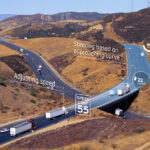Comparison: Iveco to the four!
Comparison: Iveco to the four!
Iveco has over 150 years of experience in designing and building trucks. In this tribute to flagship truck developments by the Italian brand over the past four decades, OLIVER WILLMS and a team of testers take four iconic vehicles – the Iveco TurboStar, EuroStar, Stralis, and S-Way – and put them to the test…
When four generations of trucks – representing almost four decades of trucking history – came together for a family reunion in Ulm, Germany, there was plenty to talk about. The past four decades have, after all, seen huge advances in trucks – most notably the level of comfort for the driver, as well as technological improvements. We have seen changes and developments influenced by political and business demands. Traffic flow, ecology, and the economy have imposed their own demands, helping to shape each truck generation.
Like most brands, Iveco has had its ups and downs over this period – with the perception of the brand shifting with each model. From the ‘bull’ shape of the Magirus era, the image of the heavy Iveco in the minds of many drivers and road transport company owners was of a low-cost Italian player. Despite enormous technical innovations, the long-serving Stralis range did not really alter that perception, with Iveco viewed mainly as a mainstream midfielder. It has taken the introduction of the completely revamped new S-Way series to move Iveco into the upper echelons of the heavy-duty truck ranks.
Certainly, the Italian brand is more popular than ever, thanks in no small part to the S-Way’s well-executed driver’s cab with appealing technical solutions. The flagship 570-hp model featured in this unique comparison test at the Ulm test track.
But first, in chronological order, let’s take a look at the S-Way’s predecessors, starting with what many consider the best Iveco of all: the TurboStar.
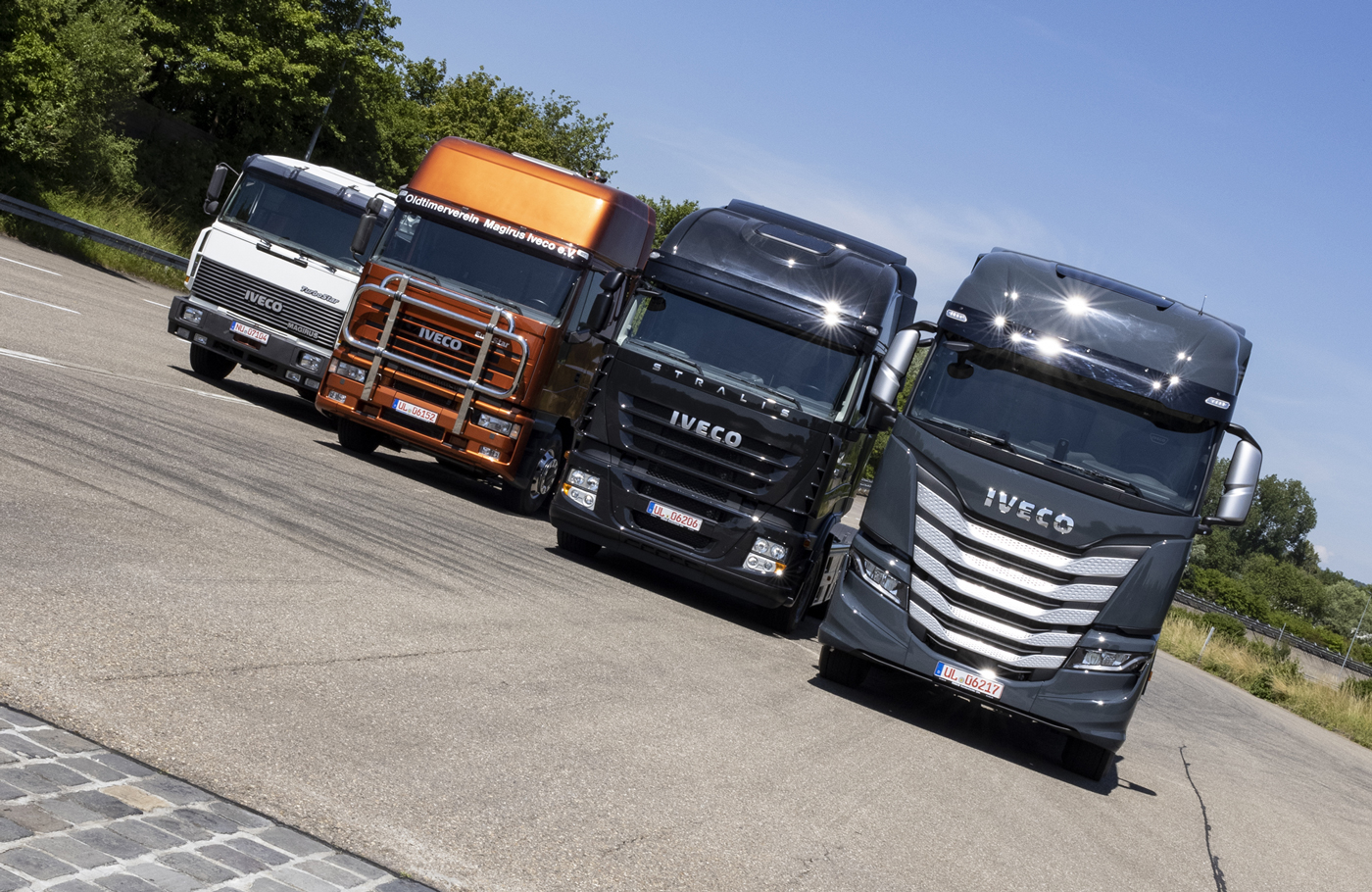
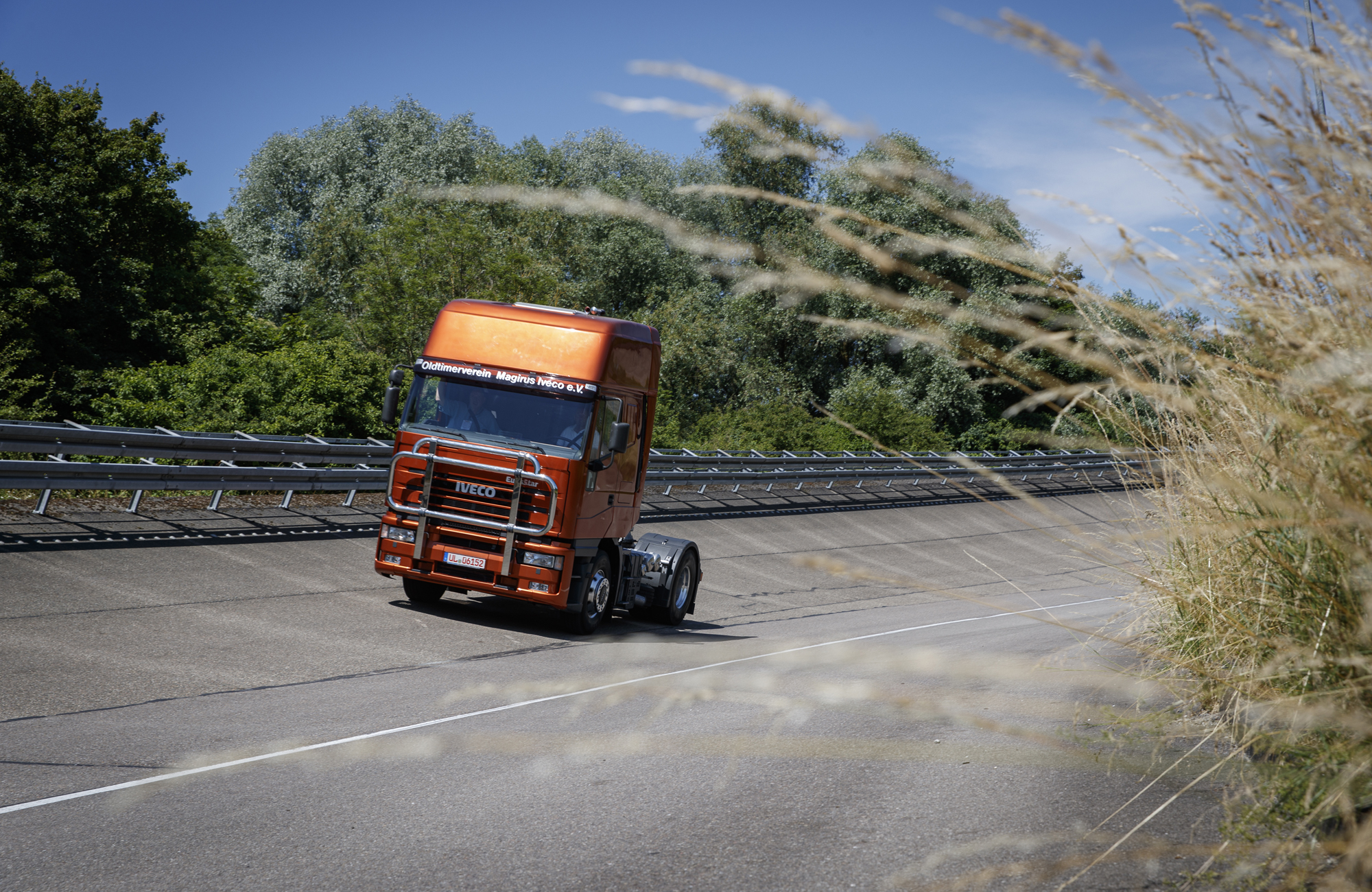

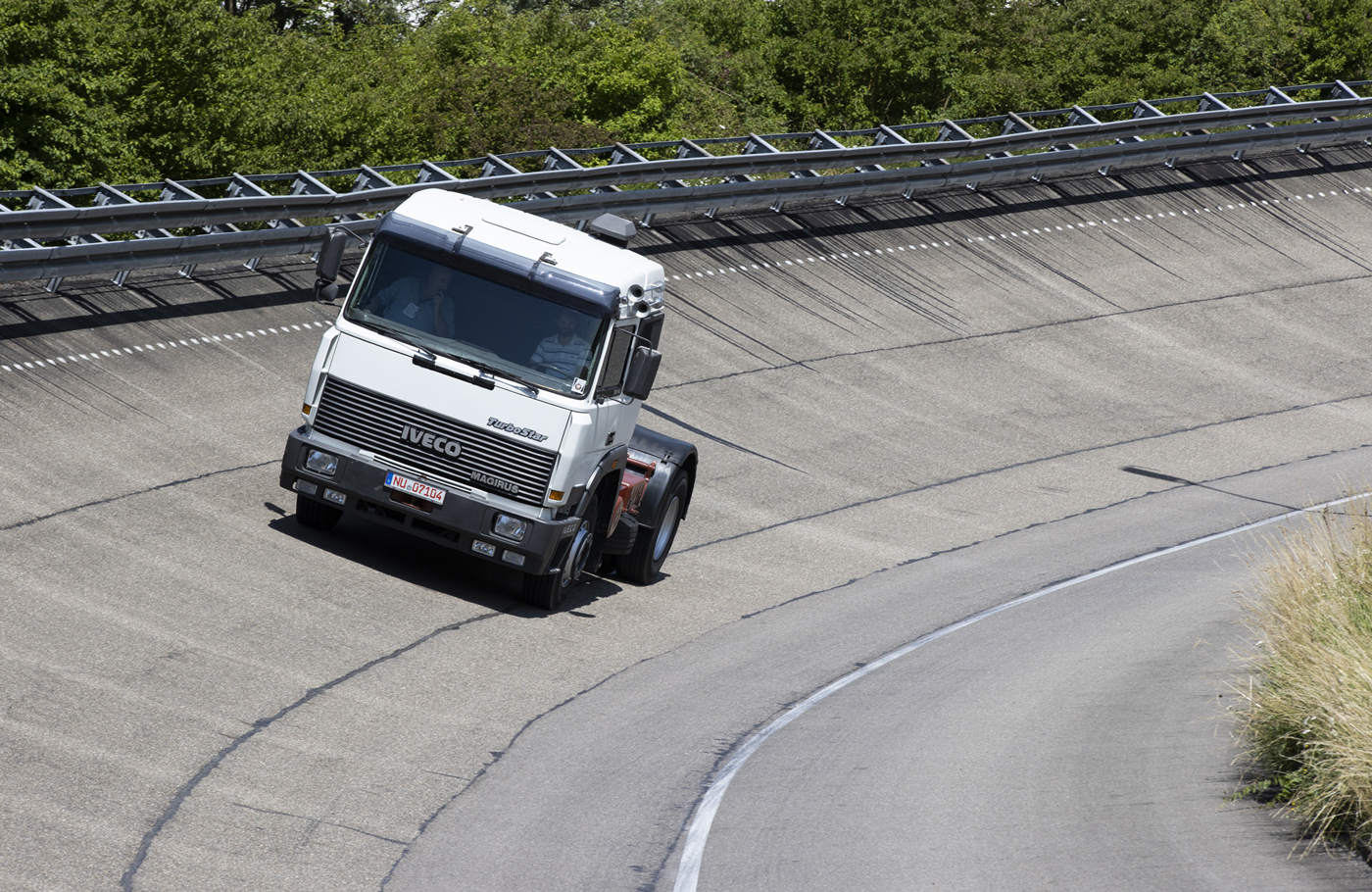
TurboStar: The power and the glory
With all the models lined up, this 1986 TurboStar was the first to attract interest from the curious and enthusiastic testers. From today’s perspective, it has an amazingly compact, yet large-capacity driver’s cab, with a purring V8 unashamedly rumbling its cult Euro Zero song.
The TurboStar takes its passengers back to a time when the legendary Franz Meersdonk steered a red 190-42 on scheduled freight movements to all corners of the world in the German TV series Auf Achse (On the Move). This was a time of no mobile phones and user-friendly disc tachographs. Back then, very – let’s say – flexible timetables on long-distance routes to the Eastern Block promised truck drivers extreme freedom. Of course, there were certain compromises in terms of comfort. From today’s perspective, at least, the TurboStar was blessed with a refreshingly honest chassis that never let you forget its contact with the road.
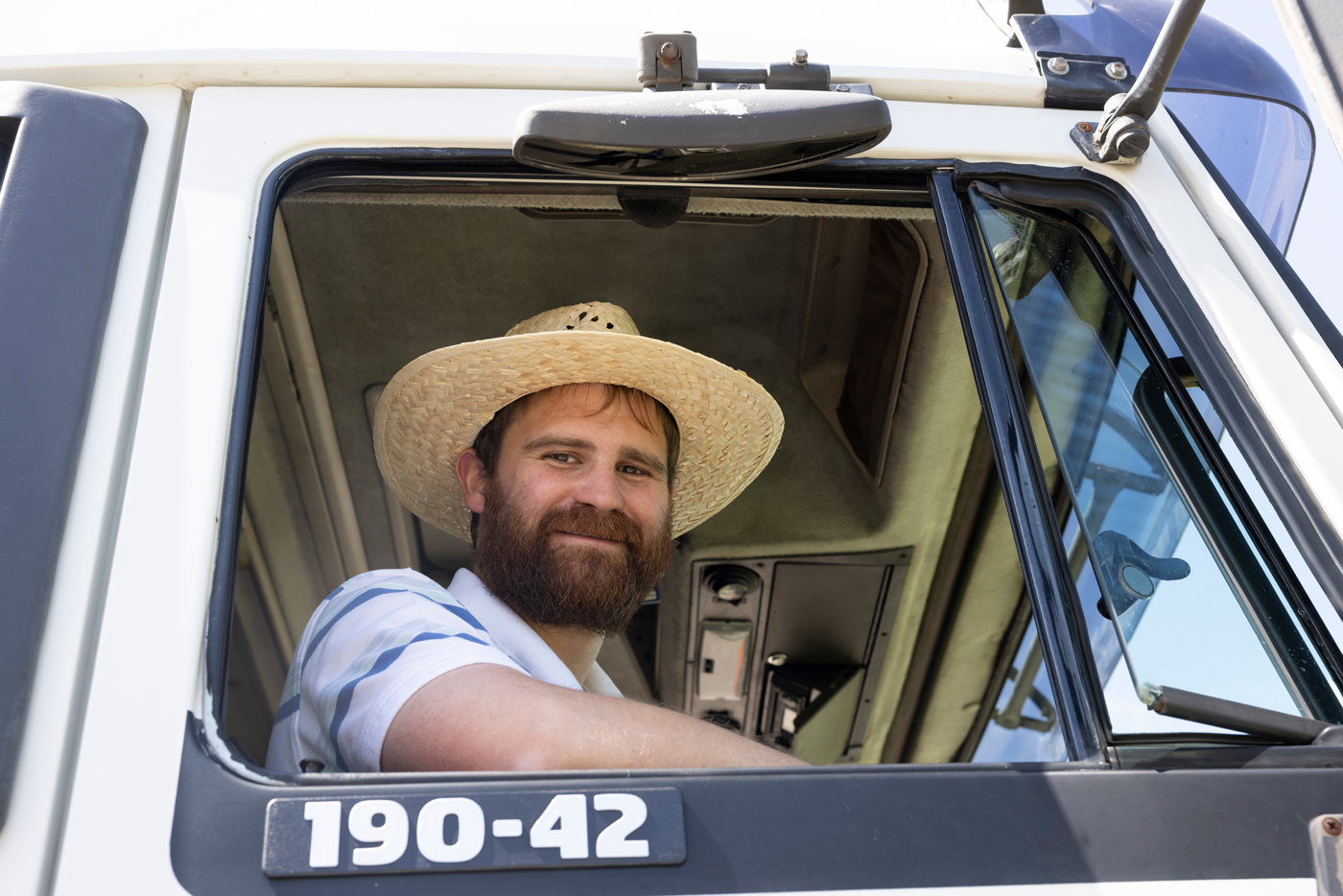
In its heyday more than 30 years ago, the large Iveco, which was still based on Fiat truck heritage, was a lavishly motorised long-distance star with its 420 hp and powerful 1 900 Nm of torque. In 1990, the performance even topped 476 hp. This now veteran truck has lost none of its masculine charisma to this day. Six years ago, Iveco test engineer Sebastian Liggefeld saved one ‘oldie’, with a million kilometres on the odometer, from being transported to Africa, getting it back into shape with a lot of enthusiasm and restoration work.
Mastering the handling of the unsynchronised Eaton Twin Splitter is tricky, but those who manage to do so are rewarded by the orchestrally pleasing sound of the potent V8. Iveco Friends Club member Liggefeld is one of the people happy about the “awesome sound” and the undiluted driving experience of this extremely vigorous old-timer. The truck and driver are the same age, and Liggefeld likes nothing better than to hitch a Kögel trailer to his white giant and take it for a tour. Even without assistance systems, seat belts, or entertainment systems, nothing beats a journey accompanied by the addictive sound of that huge V8 twin turbo!
EuroStar: Heading into the 90s
The TurboStar’s successor, the EuroStar – which made its debut in 1993 – kept the powerful V8 between the front wheels, at least for the 520-hp flagship model, although the improved driver’s cabin insulation noticeably dampened the sound experience at the wheel. That’s how it was intended, because the EuroStar was a revolution at the time, coming with a completely new driver’s cab, cockpit, and chassis. Only when it came to the drive did Iveco initially continue to rely on the legendary 13.8-litre six-cylinder, which filled the performance gap between the 10-litre engine and the V8 perfectly.

The EuroStar introduced modern ergonomics and design into the cockpit. These included regulated climate management and a number of new service functions from the driver’s seat, while the high-roof cab set new standards by offering a full driver standing height – a real selling point at the time. Even today, you feel in good hands in the cab, even if the cold start aid and the engine brake with a foot kick on the engine brake button seem a bit archaic.
Up until the mid-1990s, gears were shifted manually, either on the 16-stage ZF syncro gearbox or with 13 unsynchronised Eaton gears. With the switch, the gears still slide quickly through the double H. While the clutch pedal has been completely erased from memory these days, in 1995 – when most manufacturers still swore by manual gear selection –Iveco had the first automated gearshifts on the list of options and (mostly) in the hearts of the drivers too.
The image of the EuroStar was let down by certain fittings with poor plastic quality – a reputation which, despite its solid all-rounder qualities, was difficult to drive out of the minds of customers. In general, though, EuroStar pushed the door to modern technology wide open for Iveco. A bit of an unrewarded hero that deserves better than its reputation, hardworking examples of the EuroStar still live on.
Stralis: Impressing operators for 18 years
From 2002, Iveco’s heavy-duty offering continued with a new name and a new look. The EuroStar was history; long live the Stralis!
Modern four-valve engines from the Cursor family with eight-, 10-, and 13-litre capacities replaced all previous power plants, as manufacturers moved towards displacement downsizing. Automated switching and the increased use of electronics were features of the new truck. The Stralis also took on the role of the EuroTech in the mid-range segment, resulting in one name and one face for all road-going Iveco trucks from 270 to 560 hp.
Over the course of its illustrious 18-year career, the Stralis received continual updates, enjoying significant facelifts over the years. While the driver’s cab structure remained the same, the interior was subject to constant further development. That included upgrades to the multifunction steering wheel, evolving instrument design, and updates to the table, rearrangeable bunk, and other gimmicks in the high-roof cab.
Soon after its launch, the Stralis won the coveted title of “International Truck of The Year” in 2002, repeating that success in 2013 when the new edition rolled off the assembly line under the name Stralis Hi-Way.
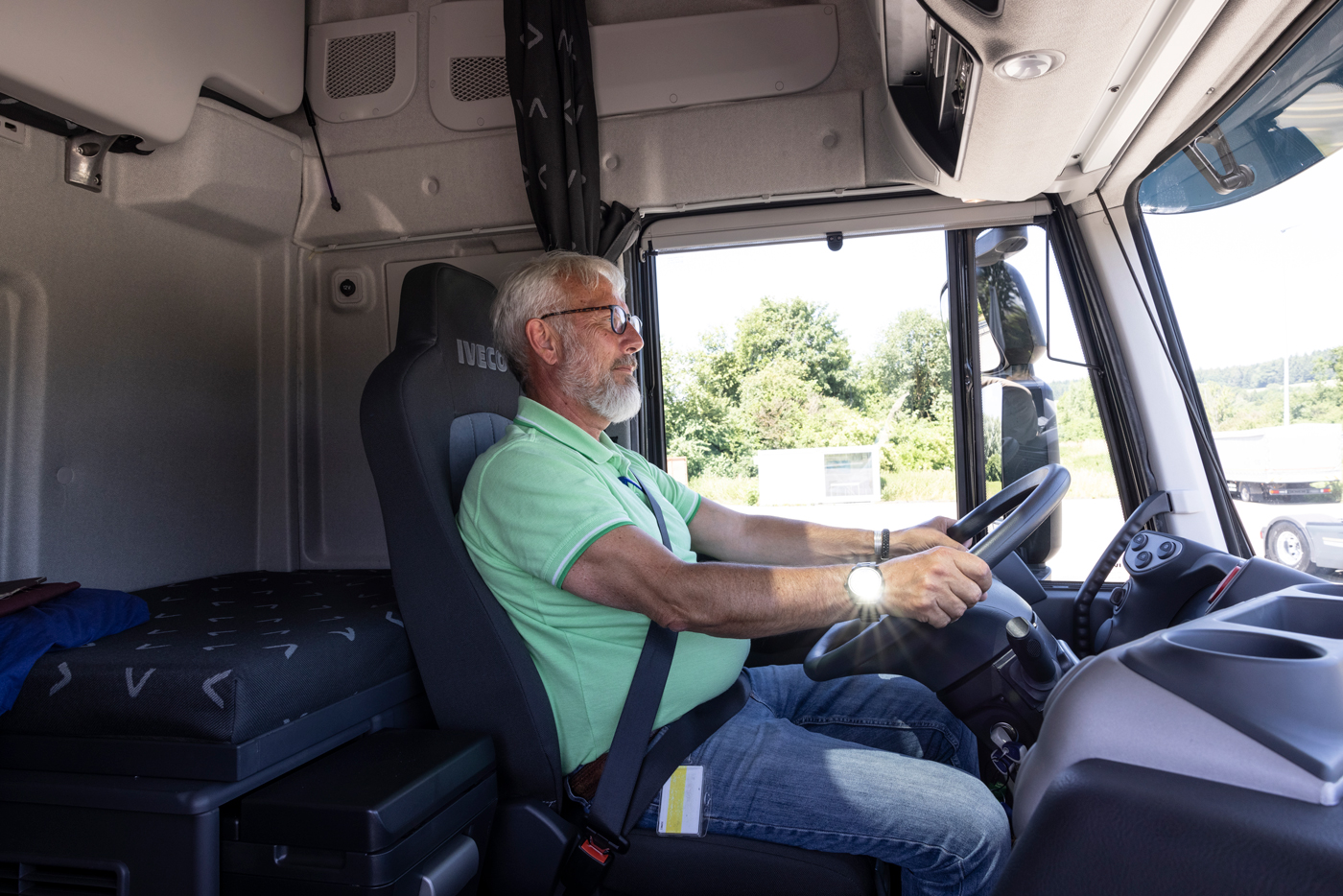
The Stralis tested here – the last one manufactured in Ulm, in 2012 – was rather special. It had actually not driven much further than from the production line to the parking lot in the previous nine years, but we were allowed to hook it up to a test trailer for the first time. After 2012, truck production in Ulm was abandoned and relocated to the more cost-effective Madrid plant, where Pegaso trucks were still assembled up until the 1990s.
On the move, with 420 hp from a comparatively small 10.3-litre displacement, performance was unspectacular, yet brisk enough to get going on its first kilometres on roads in and around Ulm. During braking and automated shifting, all with a bit of assistance from the onboard computer, this Stralis did its job discreetly and well.
In its time, the Stralis also shaped a new direction for freight transport, introducing the first functioning liquefied natural gas (LNG) truck to the market. The Stralis NP made the natural gas truck suitable for long-distance transport and passed this advantage on to its successor, the S-Way NP.
S-Way: On the road to success since 2020
Now, it’s finally the turn of the S-Way to tell its story. Since its surprise debut in Madrid – no one expected it to be quite so chic – the S-Way has raced down the road to success. This new truck has been well received, both by transport companies and by drivers, who are usually sceptical at first.
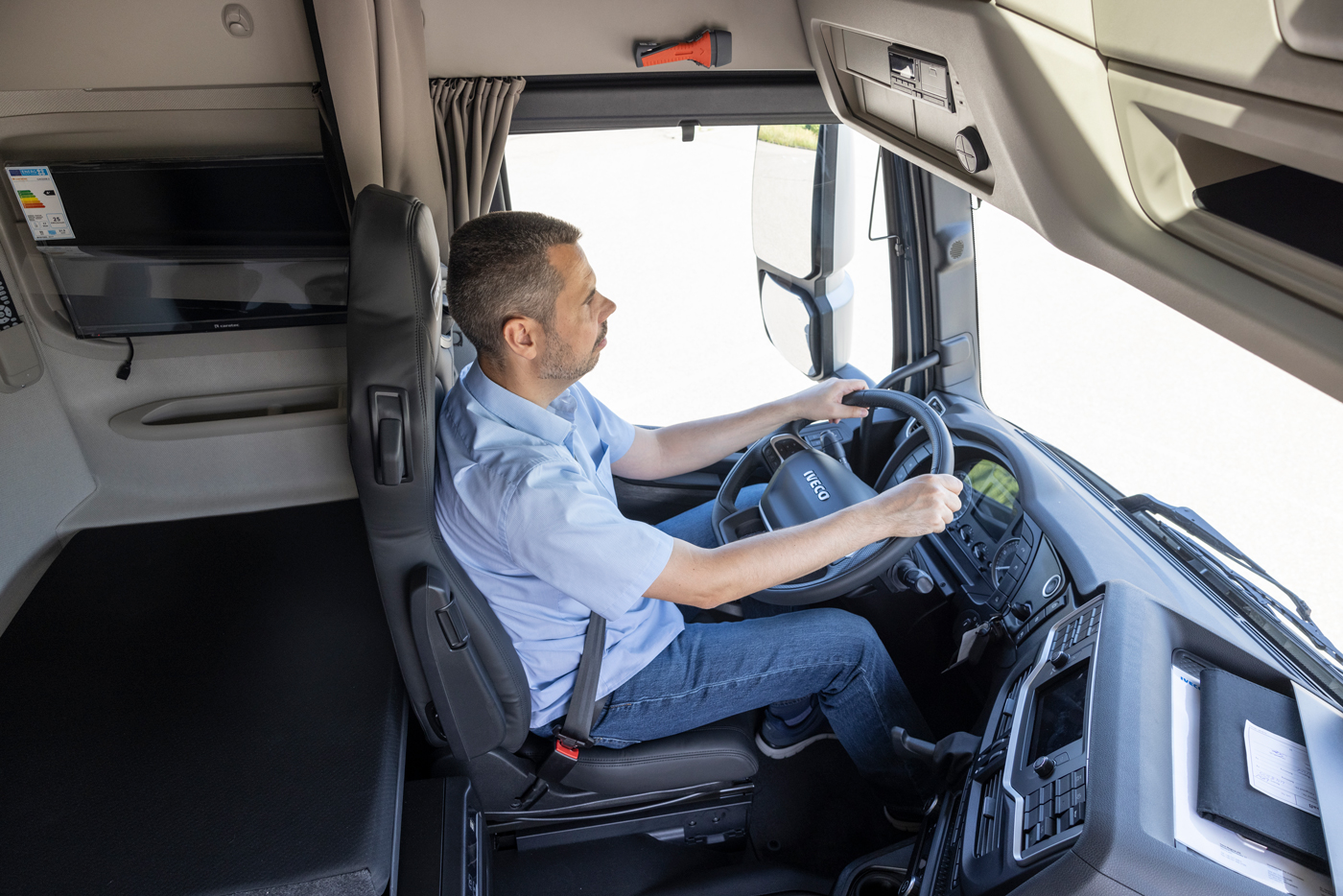
The driver’s cab has been significantly revised compared to the Stralis, with its interior brought up to date – well, almost, because the S-Way and its drivers are spared the ‘big digital touch’ for the time being. The interior is exemplified by the spacious driver’s cab, practical storage compartments and shelves, and the mechanical steering wheel adjustment.
The 13-litre six-cylinder in the test truck generates an impressive 570 hp, which the ZF TraXon 12-speed automated gearbox confidently transmits to the drive wheels. Of course, with the package of assistance systems, its exuberant performance, and the 2 500 Nm of torque, the beautiful S-Way mercilessly outshines its relatives in all disciplines.
The S-Way seems to enjoy being the superior one, just as much as the sprightly TurboStar was in its day, with its uninhibited roaring exhalation through eight cylinders. The S-Way’s time as a worry-free diesel-drinking truck is here and now, though the new Nikola e-trucks, the S-Way’s designated successors, are already being assembled within sight in a hall on the Ulm factory premises. With developments like this, it may well be less than 35 years before the S-Way appears as a spry grandfather at family reunions, remembering the good old days of 2023.
SPEC CHECK | ||||
MAKE/MODEL | TurboStar 190.42 | EuroStar 440S52 | Stralis 440S42 | S-Way 440S57 |
PRODUCTION YEAR | 1986 | 1993 | 2012 | 2021 |
ENGINE | 17.2-litre V8 Euro 0 | 17.2-litre V8 Euro 2 | 10.3-litre R6 Euro 5 | 12.9-litre R6 Euro 6D |
POWER (hp @ r/min) | 420 @ 1 800 | 510 @ 1 800 | 420 @ 1 500 – 2 100 | 570 @ 1 900 |
TORQUE (Nm @ r/min) | 1 900 @ 1 100 | 2 160 @ 1 250 | 1 900 @ 1 050 – 1 550 | 2 500 @ 1 000 |
TRANSMISSION | 13-speed Eaton manual | 16-speed synchromesh | 12-speed ZF automated | 12-speed TraXon automated |
UNLADEN WEIGHT (kg) | 7 730 | 7 130 | 6 895 | 7 180 |
WHEELBASE (mm) | 3 485 | 3 650 | 3 610 | 3 800 |
TIMELINE | 1984 – 1993 | 1993 – 2002 | 2002 – 2020 | 2020 – |
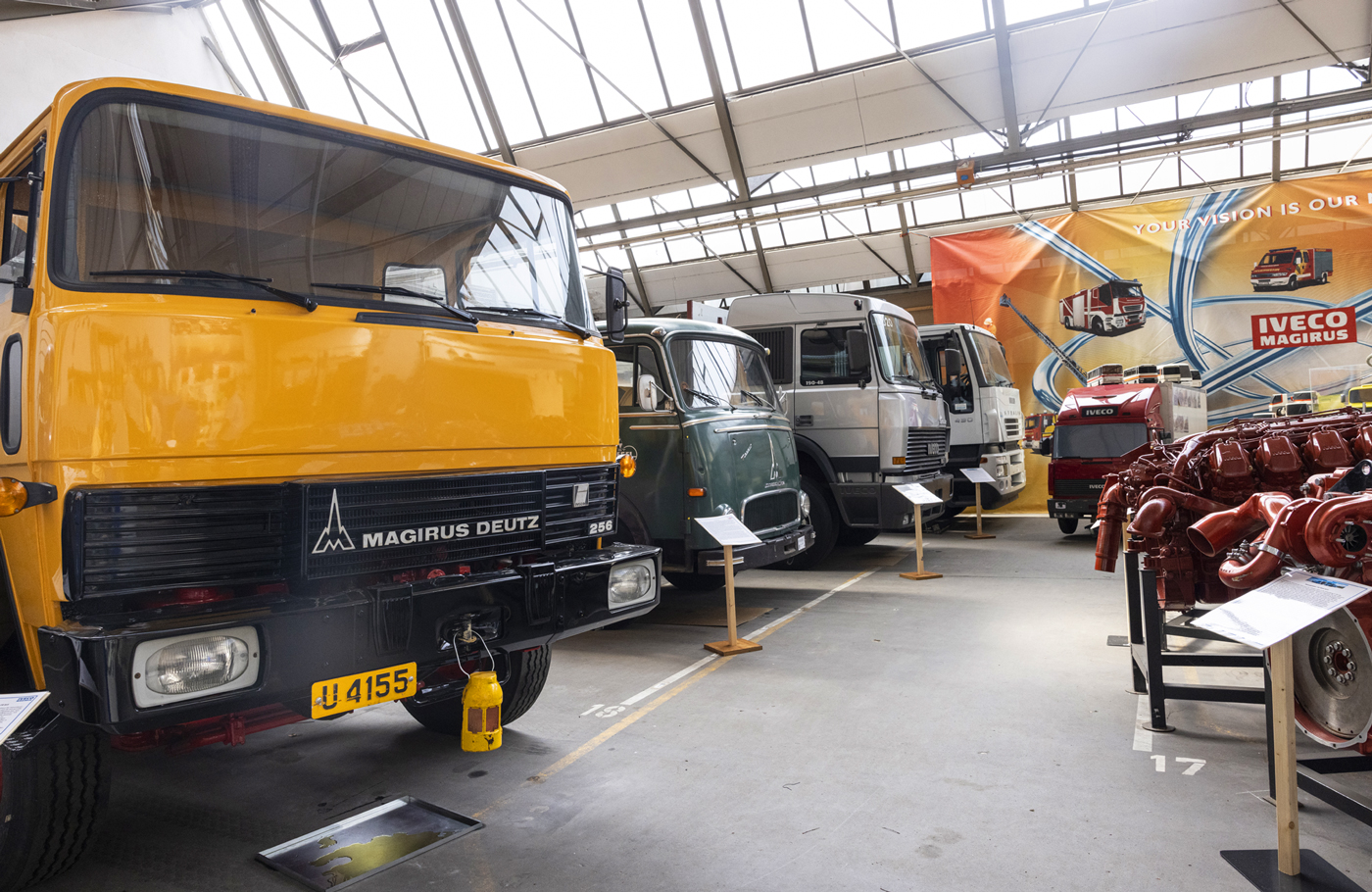
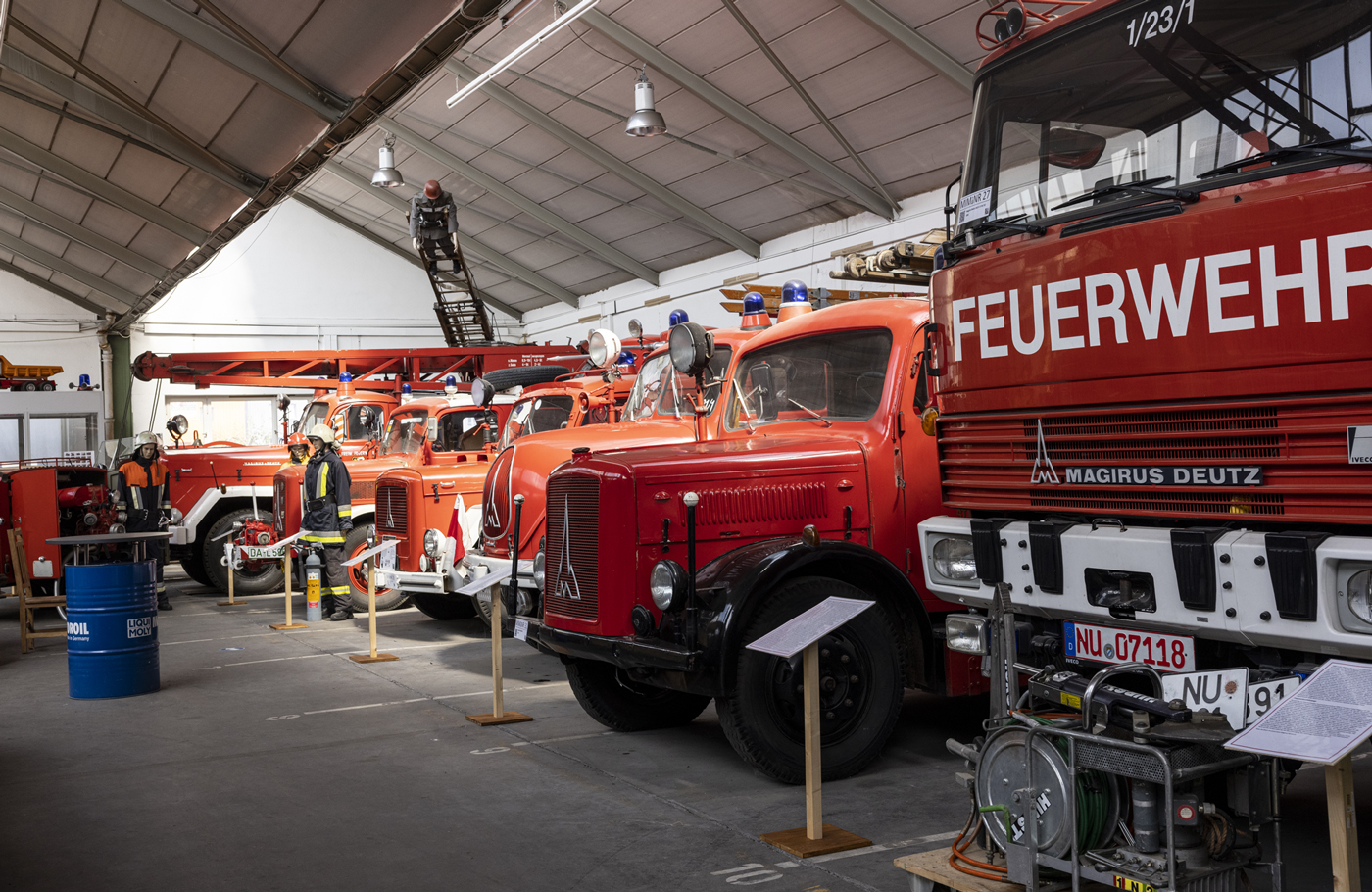
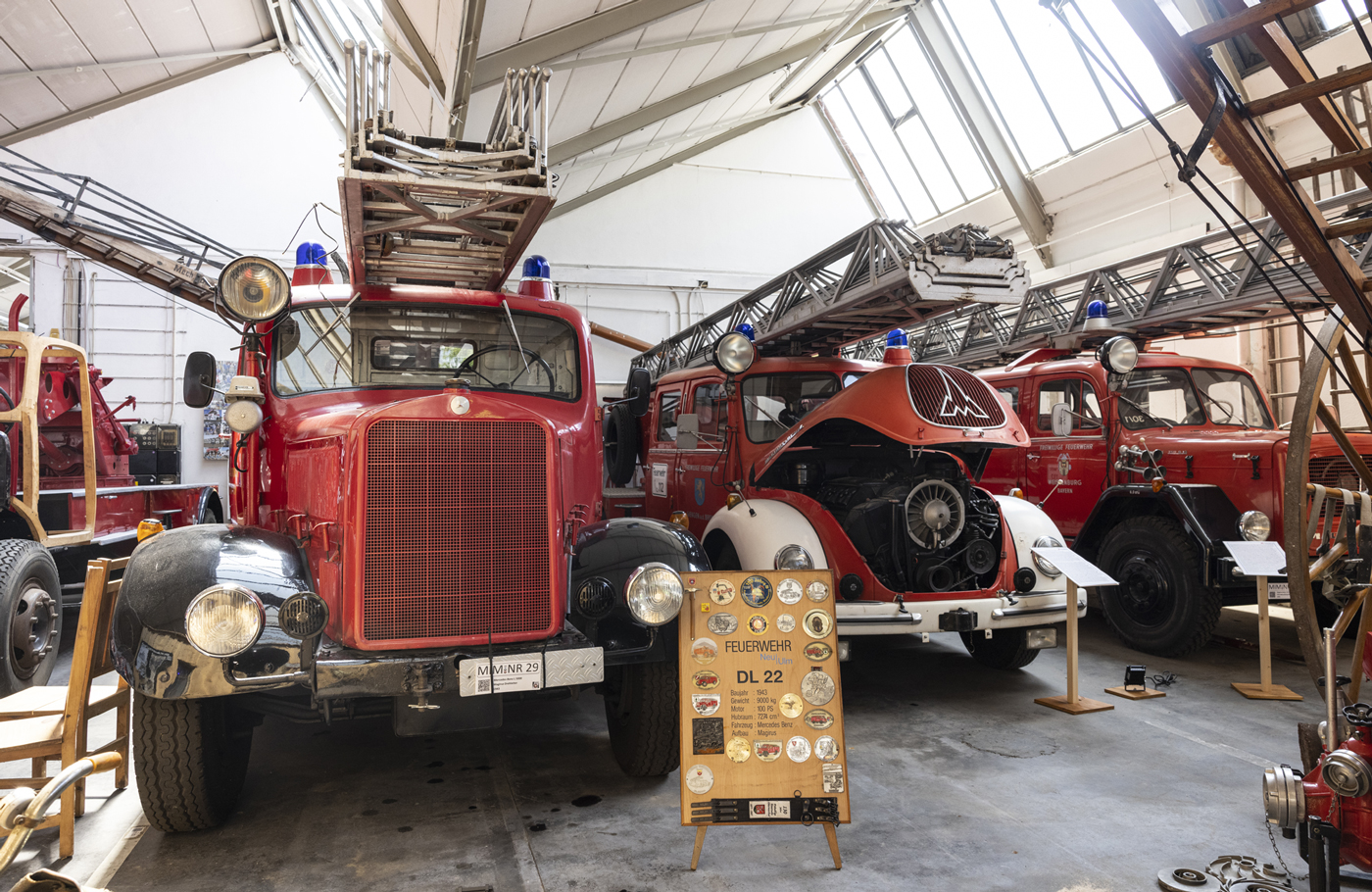
Magirus-Iveco Museum: Lovingly arranged truck history
The Magirus Iveco Museum, run privately on a voluntary basis by the Association of the same name, is a real gem in the ranks of German truck collections. In the newly occupied halls in Neu-Ulm’s Baumgartenstrasse, there are mainly old Magirus trucks, some of which are lovingly staged in contemporary settings, like a workshop facility. In addition to the legendary alligator hoods, early Magirus forward control arms and light distribution trucks are joined by the red fire brigade tender, all playing an important role in the exhibition area.
The active museum personnel, under the direction of Magirus veteran Peter Burkhart, also display a number of additional trappings – from engines to tools, special equipment, and model collections. Magirus owners are also helped with free specialist advice, photos, and documentation downloads (free of charge), through to the sale and brokerage of rare historical documents, operating instructions, or repair manuals. All proceeds flow into the preservation and expansion of the museum, which is well worth seeing.
Museum association annual membership of just €35 actively supports the continued existence of this great oldie collection.
The staff at the museum would, of course, be particularly happy about attracting sponsorship from any interested company, and donations are welcomed. Those wishing to visit should arrange an appointment in advance. Further information is available here.
Published by
Focus on Transport
focusmagsa






